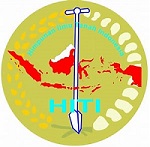Identification Of Potassium, Organic Carbon and Soil Ph on Sloping Land of Cabbage Crops at Agrotourism Area Rurukan Sub-District
DOI:
https://doi.org/10.35791/saej.v2i1.58866Keywords:
sloping land, plant available nutrient, Rurukan agrotourism areaAbstract
This study aims to identify nutrient levels of potassium, organic carbon and soil pH on sloping land of cabbage crops at agrotourism. area, rurukan sub-district. The method used in this study is a descriptive method whose implementation is field surveys to ensure the three sampling points, samples taken from different slopes and representing each slope; upper slope (LA), middle slope (LT), and lower slope (LB). Sampling of soil at a 0-20 cm depth in the soil. Parameters observed included the availability of potassium (Bray I method), organic carbon (Walkley and Black method), and soil pH (H2O using pH meter). The results of laboratory analysis showed sequential values on the upper slope, the middle slope, and the lower slope available potassium varied, 30.11 ppm; 27.11 ppm; and 31.67 ppm, the organic carbon value is relatively high, 3.27%; 3.20%; 4.78% and the unit value of soil pH is classified as neutral, 6.72; 6.69; 6,79.
Keywords: sloping land, plant available nutrient, Rurukan agrotourism area
Abstrak
Penelitian ini bertujuan untuk mengidentifikasi kadar hara kalium, karbon organik, dan pH tanah pada lahan miring pertanaman kubis di kawasan agrowisata Kecamatan Rurukan. Metode yang digunakan dalam penelitian ini adalah metode deskriptif yang pelaksanaannya adalah survei lapangan untuk memastikan tiga titik pengambilan sampel, sampel diambil dari lereng yang berbeda dan mewakili masing-masing lereng; lereng atas (LA), lereng tengah (LT), dan lereng bawah (LB). Pengambilan sampel tanah pada kedalaman 0-20 cm di dalam tanah. Parameter yang diamati meliputi ketersediaan kalium (metode Bray I), karbon organik (metode Walkley dan Black), dan pH tanah (H2O menggunakan pH meter). Hasil analisis laboratorium menunjukkan nilai berurutan pada lereng atas, lereng tengah, dan lereng bawah kalium tersedia bervariasi, 30,11 ppm; 27,11 ppm; dan 31,67 ppm, nilai karbon organik relatif tinggi, 3,27%; 3,20%; 4,78% dan nilai satuan pH tanah tergolong netral, 6,72; 6.69; 6,79.
Kata kunci: lahan miring, ketersediaan hara tanaman, kawasan agrowisata Rurukan
References
Arifin, M., N.D Putri, A. Sandrawati, & R. Harryanto, R. 2018. Pengaruh Posisi Lereng terhadap Sifat Fisika dan Kimia Tanah pada Inceptisols di Jatinangor. Soilrens, 16(2), 37-44. http://jurnal.unpad.ac.id/soilrens/article/view/37-44 diakses pada tanggal 23 Mei 2023.
Arsyad, S. 2010. Konservasi Tanah dan Air. IPB press. Bogor. Dalam Huntojungo, I., J. M. Supit, J. Husain, & R. I Kawulusan. 2013. Erosi dan Infiltrasi pada Lahan Hortikultura Berlereng di Kelurahan Rurukan. e-journal COCOS Vol. 2(3). https://ejournal.unsrat.ac.id/index.php/cocos/article/view/1512 diakses pada tanggal 10 Juni 2023.
Hakim, N., Nyakpa, M.Y., Lubis, A.M., Nugroho, S.G., Diha, M.A., Hong, G.B. dan Bailey, H.H. 1986. Dasar-Dasar Ilmu Tanah. Universitas Lampung. Lampung. 488 hal. Dalam Amalia, M.P. 2020. Identifikasi Kandungan Unsur Hara pada Lahan Tambang Desa Talawaan. Skripsi. Universitas Sam Ratulangi. Manado.
Hanafiah, K. A. 2005. Dasar-Dasar Ilmu Tanah. Jakarta: PT Raja Grafindo Persada. Dalam Mahdalina, Zarmiyeni & N. Hafizah. 2019. Respon Pertumbuhan dan Hasil Tanaman Kubis (Brassica oleracea L.) terhadap Berbagai Dosis Pupuk Kandang Kotoran Itik dengan Penambahan Abu Sekam pada Tanah Rawa Lebak. Jurnal Sains STIPER Amuntai; 9(1): 1-8.
Hardjowigeno S. 2007. Ilmu Tanah. Akademik Presindo. Jakarta. Dalam Nopsagiarti, T., D. Okalia, & G. Markina. 2020. Analisis C-Organik, Nitrogen dan C/N Tanah Pada Lahan Agrowisata Beken Jaya. Jurnal Agrosains dan Teknologi, 5(1): 11-18. https://jurnal.umj.ac.id/index.php/ftan/article/view/5889 diakses pada tanggal 28 Februari 2023.
Hardjowigeno, S. 2007. Ilmu Tanah. Akademik Pressindo. Jakarta
Huntojungo, I., J. M. Supit, J. Husain, & R. I Kawulusan. 2013. Erosi dan Infiltrasi pada Lahan Hortikultura Berlereng di Kelurahan Rurukan. e-journal COCOS Vol. 2(3). https://ejournal.unsrat.ac.id/index.php/cocos/article/view/1512 diakses pada tanggal 10 Juni 2023.
Junita, R. 2019. Analisis Faktor Produksi dan Efisiensi Usaha tani Kubis di Desa Serang Kabupaten Purbalingga. Thesis. Universitas Muhammadiyah Purwokerto.
Kumalasari, S. W., S. Jauhari, & Sumarno. 2011. Studi Beberapa Sifat Fisika dan Kimia Tanah pada Berbagai Komposisi Tegakan Tanaman di Sub DAS Solo Hulu. Jurnal Sains Tanah. Vol 8(2):119-124. https://jurnal.fp.uns.ac.id/index.php/tanah/article/view/7/7 diakses pada tanggal 26 Februari 2023
Nurhidayati. 2017. Kesuburan dan Kesehatan Tanah: Suatu Pengantar Penilaian Kualitas Tanah Menuju Pertanian Berkelanjutan. Intimedia. Malang.
Pemerintah Kota Tomohon. 2023. Geografis Kota Tomohon: https://tomohon.go.id/geografis/ diakses pada tanggal 6 Maret 2023.
Tambunan, R., U. A. Rajamuddin, dan A. R. Thaha. 2018. Beberapa Karakteristik Kimia Tanah pada Berbagai Kelerengan DAS Poboya Kota Palu. e-J. Agrotekbis 6 (2):247 - 257. http://jurnal.faperta.untad.ac.id/index.php/agrotekbis/article/view/355 diakses pada tanggal 7 Maret 2023.
Utomo, M., T. Sabrina., J.L Sudarsono., B. Rusman., Wawan. 2016. Ilmu Tanah: Dasar-dasar dan Pengelolaan. Kencana: Prenada Media Group. Jakarta.
Downloads
Published
How to Cite
Issue
Section
License
Copyright (c) 2024 Priskila Meilany Ruga Bubun, Karamoy Lientje Theffie, Rafli Irland Kawulusan

This work is licensed under a Creative Commons Attribution-NonCommercial 4.0 International License.
Authors who publish in this journal agree to the following terms:
Authors hold their copyright and grant this journal the privilege of first publication, with the work simultaneously licensed under a Creative Commons Attribution License that permits others to impart the work with an acknowledgment of the work's origin and initial publication by this journal.
Authors can enter into separate or additional contractual arrangements for the non-exclusive distribution of the journal's published version of the work (for example, post it to an institutional repository or publish it in a book), with an acknowledgment of its underlying publication in this journal.
Authors are permitted and encouraged to post their work online (for example, in institutional repositories or on their website) as it can lead to productive exchanges, as well as earlier and greater citation of the published work (See The Effect of Open Access).




